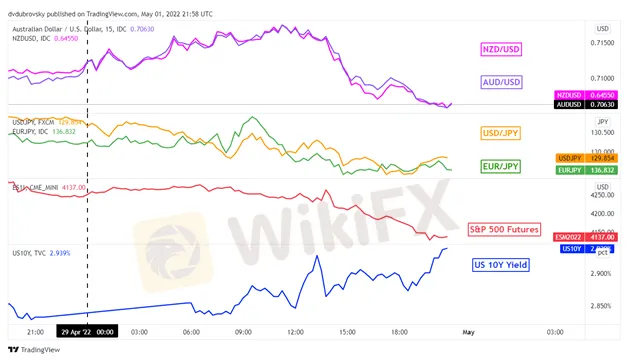简体中文
繁體中文
English
Pусский
日本語
ภาษาไทย
Tiếng Việt
Bahasa Indonesia
Español
हिन्दी
Filippiiniläinen
Français
Deutsch
Português
Türkçe
한국어
العربية
NASDAQ 100, JAPANESE YEN, FEDERAL RESERVE, CHINA PMI, CHINESE YUAN – ASIA PACIFIC MARKET OPEN
Abstract:FRIDAYS MARKET RECAP – NASDAQ 100, WORST MONTH SINCE 2008, US SPENDING, US DOLLAR, YEN
Nasdaq 100 sank on Friday, seeing worst month since the 2008 financial crisis
Anti-risk Japanese Yen received a break as traders flocked to its safety in droves
More turmoil to come before the Fed? Keep an eye on Caixin Chinese PMI data
Aggressive risk aversion plagued the last trading day of the week on Wall Street. On Friday, futures tracking the Nasdaq 100, Dow Jones and S&P 500 declined 4.48%, 2.8% and 3.64% respectively. In fact, April was the worst month for the Nasdaq 100 since October 2008, back when the global financial crisis wreaked havoc on financial markets. You would have been lucky to find a sector that didnt underperform.
So, what likely dented risk appetite? One could point to another round of solid US inflation-adjusted consumer spending data. Real personal spending rose 0.2% in March versus -0.1% anticipated. This was primarily boosted by services, rather than merchandise purchases, a sign of reversion back to pre-pandemic trends. Treasury yields surged across maturity spectrums, underscoring hawkish Fed bets.
In fact, the odds of a 75-basis point rate hike from the central bank in June climbed. On the chart below, you can clearly see the impact on markets. The US Dollar gained against the sentiment-linked Australian and New Zealand Dollars. This is as the anti-risk Japanese Yen capitalized on worrisome investors, finally catching a break from persistent destruction, recently amplified by a still-dovish Bank of Japan.
KEY MARKET PERFORMANCE LAST FRIDAY – WALL STREET MELTDOWN

NASDAQ 100 TECHNICAL ANALYSIS
Where does this leave the Nasdaq 100? On the 4-hour chart below, the index seemed to reinforce the 12801 – 12942 support zone. A breakout under this range exposes lows from March 2021. Still, positive RSI divergence does show that downside momentum is fading. That can hint at a turning point to come. Above, keep a close eye on the 50- and 100-period Simple Moving Averages for resistance.
NASDAQ 100 4-HOUR CHART

MONDAYS ASIA PACIFIC TRADING SESSION – RISK AVERSION TO CONTINUE? WATCH THE YEN AND YUAN
At the Asia-Pacific market open, the anti-risk Japanese Yen weakened as S&P 500 futures turned higher. This could perhaps be a sign of bears taking profit. Still, the proximity of the Federal Reserve rate decision could make it difficult for markets to fund sustainable upside momentum. As such, perhaps this may offer the Japanese currency some breathing space in the interim.
Over the weekend, China released April PMI data. Manufacturing figures clocked in at 47.4 against the 47.3 estimate. Readings below 50 indicate shrinking activity. While that was better than expected, non-manufacturing shrank to 41.9 against the 46.0 estimate. This is a clear sign of the governments Covid-zero policy denting economic activity, which has been increasingly associated with a weaker Yuan. Private surveys of equivalent Chinese activity will cross the wires later in the session.
USD/JPY TECHNICAL ANALYSIS
On the daily chart, USD/JPY was unable to hold a push above the 78.6% Fibonacci extension at 130.42 this past Friday. It stands as key immediate resistance. Negative RSI divergence does show that upside momentum is fading. This can precede a turn lower, placing the focus on the rising trendline from March. Closing under the trendline may open the door to a meaningful turn lower. Otherwise, clearing resistance will bring USD/JPY closer to the 2002 peak at 135.16.


Disclaimer:
The views in this article only represent the author's personal views, and do not constitute investment advice on this platform. This platform does not guarantee the accuracy, completeness and timeliness of the information in the article, and will not be liable for any loss caused by the use of or reliance on the information in the article.
Read more

Forex Hedging: Is It a Trader’s Safety Net or Just an Illusion?
In the volatile world of forex trading, risk is inevitable. One widely used strategy is forex hedging, which is a useful technique designed not to eliminate risk entirely, but to reduce its potential impact. As global economic uncertainty persists, understanding how hedging works could be an essential addition to a trader’s toolkit.

Thinking of Investing? Read Must-Know Facts About Funding pips!
When you check the internet for Funding Pips, you'd be surprised to know it's filled with praise for Funding Pips but often lacks the real facts that traders need. Everything that seems too good to be true should always be verified first. It could be Fraud . So, we conducted research and collected several facts you must know about Funding Pips.

OctaFX Back in News: ED Attaches Assets Worth INR 134 Cr in Forex Scam Case
The Enforcement Directorate (ED) in Mumbai has attached assets worth around INR 131.45 crore. This included a luxury yacht and residential properties in Spain. Read this interesting story.

Oil Prices Stay Firm on Solid US Jobs Data
Oil prices stayed firm this week as the US labour department posted a better-than-expected payroll data in June 2025. Read this news in detail.
WikiFX Broker
Latest News
CFD Brokers Face Dual Compliance Pressures Ahead of 2026: Australia and EU Tighten Rules
Services Surveys Signal 'Expansion' In June, Inflation Fears Remain High
Major Risks Associated with AuxiliumFX: You Need to Know
ASIC cancels AFS licences of Ipraxis and Downunder Insurance Services
CFI Financial Group Becomes Official Online Trading Partner of Etihad Arena
FxPro to Launch Crypto Trading Desk, Deepening Digital Asset Push
Global Brokers Vs. Indian Rules: Why They Struggle in India
Discover 5 Benefits of Trading with Trive FX Broker
Indian regulator bars U.S. firm Jane Street from accessing securities market, impounds $566 million in manipulation probe
Asia-Pacific markets trade mixed ahead of Trump's deadline for higher tariffs
Currency Calculator


